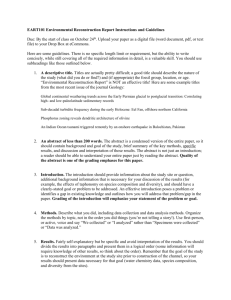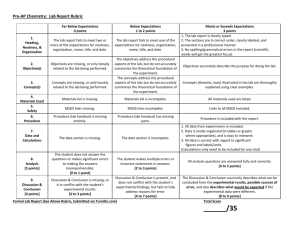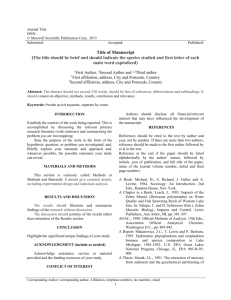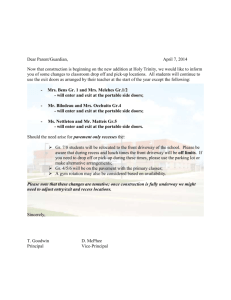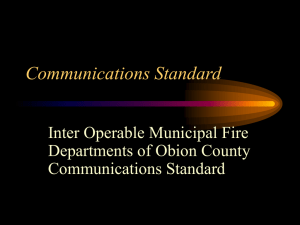Office, Classroom and General Area Inspection Key
advertisement
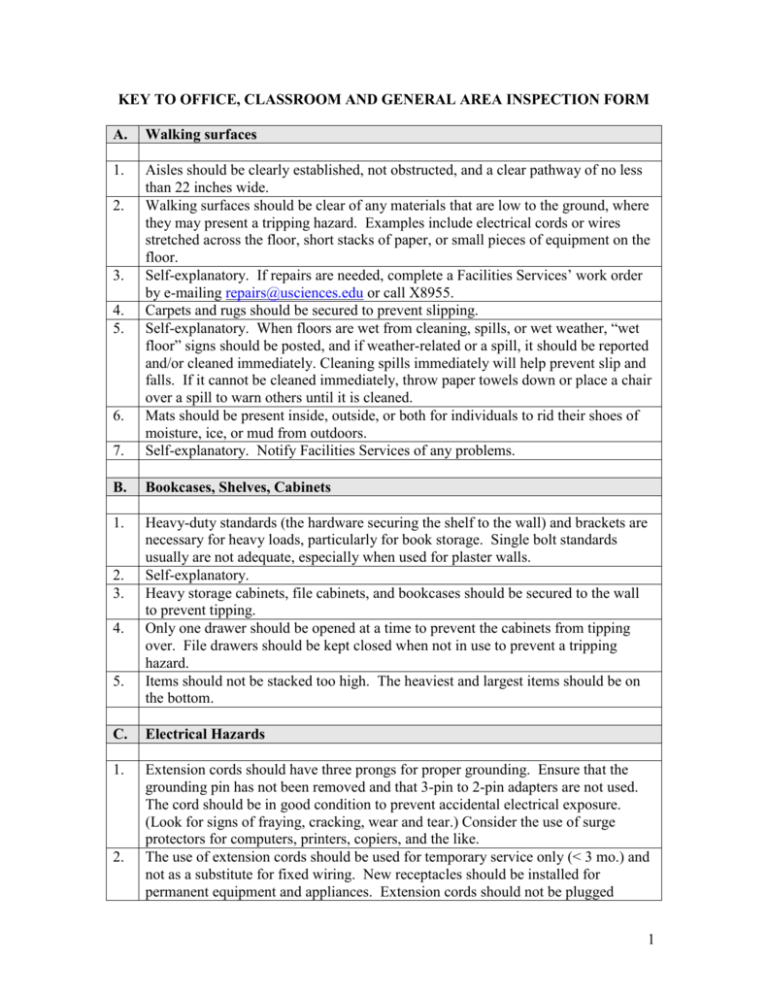
KEY TO OFFICE, CLASSROOM AND GENERAL AREA INSPECTION FORM A. Walking surfaces 1. 7. Aisles should be clearly established, not obstructed, and a clear pathway of no less than 22 inches wide. Walking surfaces should be clear of any materials that are low to the ground, where they may present a tripping hazard. Examples include electrical cords or wires stretched across the floor, short stacks of paper, or small pieces of equipment on the floor. Self-explanatory. If repairs are needed, complete a Facilities Services’ work order by e-mailing repairs@usciences.edu or call X8955. Carpets and rugs should be secured to prevent slipping. Self-explanatory. When floors are wet from cleaning, spills, or wet weather, “wet floor” signs should be posted, and if weather-related or a spill, it should be reported and/or cleaned immediately. Cleaning spills immediately will help prevent slip and falls. If it cannot be cleaned immediately, throw paper towels down or place a chair over a spill to warn others until it is cleaned. Mats should be present inside, outside, or both for individuals to rid their shoes of moisture, ice, or mud from outdoors. Self-explanatory. Notify Facilities Services of any problems. B. Bookcases, Shelves, Cabinets 1. Heavy-duty standards (the hardware securing the shelf to the wall) and brackets are necessary for heavy loads, particularly for book storage. Single bolt standards usually are not adequate, especially when used for plaster walls. Self-explanatory. Heavy storage cabinets, file cabinets, and bookcases should be secured to the wall to prevent tipping. Only one drawer should be opened at a time to prevent the cabinets from tipping over. File drawers should be kept closed when not in use to prevent a tripping hazard. Items should not be stacked too high. The heaviest and largest items should be on the bottom. 2. 3. 4. 5. 6. 2. 3. 4. 5. C. Electrical Hazards 1. Extension cords should have three prongs for proper grounding. Ensure that the grounding pin has not been removed and that 3-pin to 2-pin adapters are not used. The cord should be in good condition to prevent accidental electrical exposure. (Look for signs of fraying, cracking, wear and tear.) Consider the use of surge protectors for computers, printers, copiers, and the like. The use of extension cords should be used for temporary service only (< 3 mo.) and not as a substitute for fixed wiring. New receptacles should be installed for permanent equipment and appliances. Extension cords should not be plugged 2. 1 together to make a longer than authorized cord. 3. Equipment power cords should be replaced if damaged in any way. 4. Through normal wear and tear, the insulation may break at the point where the plug is joined to the cord, exposing the equipment user to the potential of an electrical shock. Plugs should be replaced whenever this occurs. 5. Wall outlet covers should be in place to prevent accidental exposure to electrical wiring. 6. The electrical circuit panel must be accessible at all times. Furniture, equipment or storage of materials should not prohibit access. At least 30 inches of space around the panel must be kept free from obstruction at all times, per the Philadelphia Fire Prevention Code. Circuit breakers should be labeled as to their function. 7. Electrical circuits may become overloaded with the use of multi-plug adapters. 8. Multiple outlet strips should be equipped with overload protection (such as a circuit breaker or fuse) to reduce the possibility of a fire. These units should trip the breaker if the strip becomes overloaded or if there is a surge in electricity. 9 Plugging one multiple outlet strip into another is called piggy-backing and can cause serious problems. 10. Wires or extension cords under rugs or through doorways may become damaged, creating a potential fire hazard. They should not be extended through walls, ceilings or floors, or placed under doors or floor coverings. If the cord is covered, heat cannot escape, which can result in fire. An extension cord should never be placed where it is likely to be damaged by heavy items or foot traffic. 11. GFCI’s will provide protection from electrocution in the event that the electrical ground is lost or an electrical leak occurs. GFCI’s are required on all receptacles within 5 – 6 feet of a water source (i.e., sink, eyewash) or outdoors. These should be tested monthly by individuals in the area where they are located. Older buildings could be GFCI protected at the circuit breaker panel and not at the outlet. 12. Grounded or double insulated tools will protect users from electrical shock. Grounded tools will have a three-prong plug. Double insulated tools are labeled as such, and have one of their 2 prongs visibly wider. D. Stairways, Ramps, Corridors, Storage Areas 1. Stairways, ramps and corridors should be illuminated in such a way that individuals are able to adequately see steps and walkways. Also, emergency lighting should be provided in exit stairways, lobbies, corridors, places of assembly, boiler rooms and other exit passageways to ensure that adequate lighting levels will allow for safe evacuation during a power outage. If accessible, push button on emergency lighting to check if lights illuminate. Self-explanatory. A stair tread is the horizontal stair and the covering at the nose of the stair for the purpose of reducing wear or increasing friction (to prevent slips). Notify Facilities Services of any problems. Storage in stairways or under stairways is prohibited by the Philadelphia Fire Prevention Code. Self-explanatory. Notify Facilities Services of any problems. 2. 3. 4. 5. 2 6. 7. 8. 9. Notify Facilities Services. e.g., floor openings, pits, etc. into which people can accidentally walk, wall openings where there is a drop of more than 4 ft. equipment where falling materials could create a hazard, etc. Storage in hallways and corridors should be limited. However, as a general rule of thumb, areas with an occupancy load of >50 people, 44” of a clear pathway is required. Areas with an occupancy load of <50 people, 36” of a clear pathway is required. Good housekeeping is also required by the Philadelphia Fire Prevention Code. Self-explanatory, per Philadelphia Fire Code. Ladders should be in good condition. The top “step” of a ladder or stepladder should not be used. If anyone is using ladders (other than a stepladder), training should be provided and documented by their supervisor. Consult EHRS, your supervisor or the safety manual at http://www.usip.edu/safety/omanual/ladders.htm for more information on ladder safety. E. Office Equipment 1. In order to prevent back strain and repetitive strain injuries, chairs should be in good condition and should be adjusted such that the individual may sit comfortably at the worktable or desk. See the safety manual at http://www.usip.edu/safety/omanual/ergo.htm for more information on workstation ergonomics. Contact EHRS for an ergonomic consultation. Self-explanatory. Self-explanatory. Individuals should not stand on chairs, tables, boxes or other equipment. Appropriate step stools should be used. 2. 3. F. Fire Prevention, Emergency Exits, Housekeeping 1. Equipment, desks, bicycles, shelves, boxes, decorations, etc. should not block or obstruct any fire, electrical or emergency equipment or devices, per Philadelphia Fire Prevention Code. Fire extinguishers should be inspected monthly by Facilities Services personnel and the monthly date written on tag. Also, an outside company will check, recharge, and tag extinguishers annually. Notify Facilities if a fire extinguisher’s monthly or annual inspection is out-of-date on the tag or if an extinguisher is missing. Fire extinguishers should be mounted in a visible location near laboratories, shops, kitchen areas, storage areas, places of assembly, where hazardous materials are used or stored, mechanical rooms and in the residence halls. It is recommended that they be mounted closer to an exit door or in the hallway. Self-explanatory. Fire doors must be kept unlocked and closed at all times, unless held open with a device approved per the Philadelphia Fire Prevention Code. (i.e., magnetic hold open devices) Wooden wedges must never be used to block fire doors open. Fire exit doors must close and latch properly. Exits must be clear and unobstructed at all times. The exit door must never be 2. 3. 4. 5. 6. 7. 3 8. 9. 10. 11. 12. 13. 14. locked as to prevent an occupant from exiting. All “exit” signs should be located at exit doors or exit access areas, so that they are readily visible. Sign placement should be such that any point in the exit access should not be more than 100 feet from the nearest visible sign. Exit signs must be illuminated at all times that the building is occupied. If it is ever unclear which direction to go to get to an exit, supplemental directional signs should be placed in the corridor indicating the direction to the exit. These doors or stairways must be labeled as such to prevent someone from missing an appropriate exit, and possibly becoming trapped, during an emergency. Ask yourself, can this door or stairway be mistaken for an exit? Self-explanatory. Self-explanatory. Fire hazard. Space heaters must be turned off when no one is in the room and unplugged when gone for the day. Evacuation routes must be posted in a visible location. It is recommended to place signs near elevators, stairs, at main entrances, in places of assembly, or other centrally located sites. Combustible materials are those capable of burning and igniting when exposed to heat, sparks, or flames. (such as wood, paper, cardboard, plastic, furniture, cloth, etc.) G. Classrooms, Places of Assembly 1. 2. Examine desks for broken legs and tops, splintering/protruding edges, and the like. Examine chairs for broken legs and seats, splintering/protruding edges, and the like. If chairs are bolted to the floor, check for unbolted chairs or those which are loose. H. Miscellaneous 1. Smoking is prohibited in any University building. Look for signs of smoking. (i.e., ashes, ashtrays, cigarette butts, etc.) Self-explanatory. Submit a work order for ceiling tiles that are damaged, stained or water damaged from a leak, or if any are missing. Also, a missing tile will prevent the ventilation system from working properly. Original elevator inspection notices are on file in the Facilities Services Department. Copies are posted in elevators. Self-explanatory, per Philadelphia Fire Prevention Code. 2. 3. 4. 5. I. For Special Areas: Chemical Use in Non-laboratory Areas 1. SDS’s (formerly called MSDS’s) should be in a file or book near the area where chemicals are used. Anyone working with the chemical should know the location. The SDS’s should not be locked up, so that it will be available in an emergency. A master set of all SDS’s if provided by Supervisors, as required, are available in the 4 2. 3. 4. 5. 6. 7. 8. 9. 10. 11. 12. 13. 14. 15. 16. 17. 18. Central Stockroom – Griffith Hall Basement, room #B10 and on the EHRS website at http://www.usp.edu/safety/msds.shtml in the ChemWatch/ChemGold Program. Eyewashes should be within 10 seconds access, when working with corrosives or eye injurious chemicals or materials. Nothing should ever be blocking an eyewash. (i.e., equipment, boxes, bottles, etc.) This can prevent immediate access in an emergency. Also, there should be enough water to flush for at least 15 minutes. Eye protection must always be worn whenever there is the possibility of an eye injury from flying particles and glass or from a hazardous substance splash. For example, laboratories and shop areas. Self-explanatory. Self-explanatory, also no food or drinks used for human consumption should be stored in the refrigerator/freezer. “No Food” labels are available in the Central Stockroom. No abbreviations or chemical formulas are allowed. (i.e., hydrochloric acid allowed, HCL not allowed) A chemical/hazardous waste tag should be on all chemical waste containers that have waste inside. These EHRS tags are pre-printed “chemical/hazardous waste.” The specific chemical name should then be written on the tag. Chemical and waste containers must always be sealed, unless actually adding or removing material from the container. Liquid chemical and waste containers (bottles, drums) must be stored in tubs or secondary containers which will hold the total contents if it were to leak, especially if stored near a drain. (floor, sink, etc.) Plastic tubs are available in the Central Stockrooms. Accidents will more likely occur when moving these containers on and off upper shelves. Corrosives should never be stored above eye level. Self-explanatory. The starting date of accumulation must be written on the Universal Waste label. Accumulation date begins when at least one tube is placed inside. “Universal Waste” labels are available in the Central Stockroom. Plastic tubs with lids should be used for storage. The tub must be sealed and labeled as “Hazardous Waste – PCB Containing Ballasts”. This container needs to be dated when full. Plastic tubs with lids should be used for storage. The tub must be closed and labeled with the starting date of accumulation and as “Universal Waste – Batteries”. Accumulation date begins when at least one battery is placed inside. Cylinders need to be individually restrained by chains or straps at approximately 2/3’s height from the floor (or in a cylinder cart). Cylinders must be labeled with the contents. A cylinder could act like a missile if it falls over. A protective valve cap should be screwed onto the top of the cylinder, when not connected to a regulator. Self-explanatory. Self-explanatory. 5

